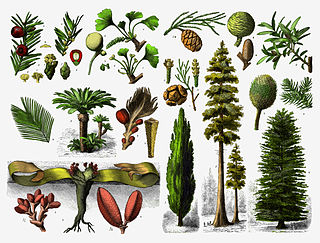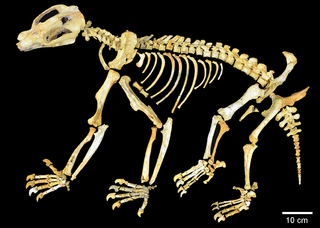
Barn-owls are one of the two families of owls, the other being the true owls or typical owls, Strigidae. They are medium to large owls with large heads and characteristic heart-shaped faces. They have long, strong legs with powerful talons. They also differ from the Strigidae in structural details relating in particular to the sternum and feet.

Diprotodontia is the largest extant order of marsupials, with about 155 species, including the kangaroos, wallabies, possums, koala, wombats, and many others. Extinct diprotodonts include the hippopotamus-sized Diprotodon, and Thylacoleo, the so-called "marsupial lion".

Cycads are seed plants that typically have a stout and woody (ligneous) trunk with a crown of large, hard, stiff, evergreen and (usually) pinnate leaves. The species are dioecious, that is, individual plants of a species are either male or female. Cycads vary in size from having trunks only a few centimeters to several meters tall. They typically grow very slowly and live very long. Because of their superficial resemblance, they are sometimes mistaken for palms or ferns, but they are not closely related to either group.

The gymnosperms are a group of seed-producing plants that includes conifers, cycads, Ginkgo, and gnetophytes, forming the clade Gymnospermae. The term gymnosperm comes from the composite word in Greek: γυμνόσπερμος, literally meaning 'naked seeds'. The name is based on the unenclosed condition of their seeds. The non-encased condition of their seeds contrasts with the seeds and ovules of flowering plants (angiosperms), which are enclosed within an ovary. Gymnosperm seeds develop either on the surface of scales or leaves, which are often modified to form cones, or on their own as in yew, Torreya, Ginkgo. Gymnosperm lifecycles involve alternation of generations. They have a dominant diploid sporophyte phase and a reduced haploid gametophyte phase which is dependent on the sporophytic phase. The term "gymnosperm" is often used in paleobotany to refer to all non-angiosperm seed plants. In that case, to specify the modern monophyletic group of gymnosperms, the term Acrogymnospermae is sometimes used.

Nothofagus, also known as the southern beeches, is a genus of 43 species of trees and shrubs native to the Southern Hemisphere in southern South America and east and southeast Australia, New Zealand, New Guinea, and New Caledonia. The species are ecological dominants in many temperate forests in these regions. Some species are reportedly naturalised in Germany and Great Britain. The genus has a rich fossil record of leaves, cupules, and pollen, with fossils extending into the late Cretaceous period and occurring in Australia, New Zealand, Antarctica, and South America.

Bennettitales is an extinct order of seed plants that first appeared in the Permian period and became extinct in most areas toward the end of the Cretaceous. Bennettitales were amongst the most common seed plants of the Mesozoic, and had morphologies including shrub and cycad-like forms. The foliage of bennettitaleans is superficially nearly indistinguishable from that of cycads, but they are distinguished from cycads by their more complex flower-like reproductive organs, at least some of which were likely pollinated by insects.

Williamsonia is a genus of plant belonging to Bennettitales, an extinct order of seed plants. Within the form classification system used in paleobotany, Williamsonia is used to refer to female seed cones, which are associated with plants that also bore the male flower-like reproductive structure Weltrichia.
The Early Miocene is a sub-epoch of the Miocene Epoch made up of two stages: the Aquitanian and Burdigalian stages.

Nimbadon is an extinct genus of marsupial, that lived from the Late Oligocene to the Miocene epoches. Many fossils have been found in the Riversleigh World Heritage property in north-western Queensland. It is thought to have an arboreal lifestyle.
Ilaria is an extinct genus of marsupial of the family Ilariidae, dating from the Late Oligocene of South Australia. Its diet consisted of leaves.
The Macropodidae are an extant family of marsupial with the distinction of the ability to move bipedally on the hind legs, sometimes by jumping, as well as quadrupedally. They are herbivores, but some fossil genera like Ekaltadeta are hypothesised to have been carnivores. The taxonomic affiliations within the family and with other groups of marsupials is still in flux.
Calocedrus huashanensis is an extinct incense-cedar species in the family Cupressaceae described from a group of isolated foliage fossils including stems and leaves. The species is known from Oligocene sediments exposed in the Guangxi Zhuang Autonomous Region, China. It is one of a number of extinct species placed in the living genus Calocedrus.

Nilssonia is a genus of fossil foliage traditionally assigned to the Cycadophyta either in Cycadales or their own order Nilssoniales, though the relationships of this genus with the Cycadales have been put into question on chemical grounds.

Zamites is a genus of sterile foliage known from the Mesozoic of North America, Europe, India and Antarctica through the Eocene of North America. It was erected as a form taxon for leaves that superficially resembled the extant cycad Zamia, however it is now believed to belong to a similar but phylogenetically different group, the cyacadeoids (Bennettitales). The fronds are linear or lanceolate in shape, and pinnately compound, with pinnae with parallel veins and smooth margins, and symmetrical and constricted at the base where they are attached obliquely to the upper surface of the rachis. It has been interpreted as a Bennettitalean plant in the family Williamsoniaceae. It is associated with the ovulate cone Williamsonia and male cone Weltricihia.
Archocyrtus is an extinct genus of small-headed flies in the family Acroceridae. The genus is known from compression fossils from the Late Jurassic Karabastau Formation of Kazakhstan. The genus is the only member of the subfamily Archocyrtinae.

Pterophyllum is an extinct form genus of leaves known from the Carnian to the Maastrichtian, belonging to the Bennettitales. It contains more than 50 species, and is mainly found in Eurasia and North America.
Pentoxylales is an extinct order of seed plants known from the Jurassic and Early Cretaceous of East Gondwana.

Otozamites is an extinct form genus of leaves belonging to the Bennettitales.
Nilssoniopteris is an extinct form genus of leaves belonging to the Bennettitales. Leaves are slender and often entire-margined (smooth-edged), though some species have dissected leaves with numerous small segments extending down to the rachis of the leaf. Nilssoniopteris-like leaves are distinguished by their syndetocheilic stomata, indicating bennettitalean affinities. Similar "taeniopterid" leaves are placed in the genus Nilssonia if their stomata are instead haplocheilic, or Taeniopteris if the cuticle is not preserved. Leaves of Nilssoniopteris vittata from the Middle Jurassic of England are associated with bisexual Williamsoniella reproductive structures.
Eoginkgoites is an extinct form genus of bennettitalean leaves from the Late Triassic of North America. Despite its palmate (hand-shaped) appearance similar to some early ginkgo species, it belongs to a different gymnosperm order, the Bennettitales. The leaf is deeply segmented into five to seven narrow, club-shaped lobes which twist around a very short rhachis. This leads to an overall fan-shaped leaf situated at the end of a long petiole. The leaf has paracytic stomata and veins which strongly branch and lead to a marginal vein at the edge of each leaflet. These structural traits are all shared with benettitaleans. Williamsonia carolinensis, an ovule-bearing bennettitalean cone, has been found closely associated with Eoginkgoites leaves, seemingly confirming its benettitalean identity.












